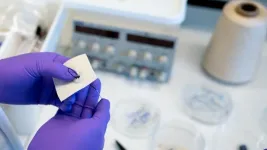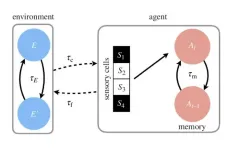(Press-News.org) WASHINGTON — While the lockdowns associated with the COVID-19 pandemic led many families to eat more meals at home, they had an additional benefit: an increase in the quality of family time during those dinners, according to research published by the American Psychological Association.
The study, published in the journal Couple and Family Psychology: Research and Practice, found that families who ate together more often during the pandemic also had more positive interactions, shared news and information, and even embraced technology such as videoconferencing to connect with distant family members.
"The predominance of past research on family dinners has focused on frequency as the key predictor of benefits for children and adolescents," said lead author Anne Fishel, PhD, a clinician and researcher in family therapy at Massachusetts General Hospital. "This study highlights the importance of examining both frequency and quality to understand the full picture of how shared meals can impact families."
Researchers examined data from a survey of 517 ethnically and socioeconomically diverse parents across the United States, administered in May 2021. Their aim was to investigate changes in family dinner frequency and quality during the COVID-19 pandemic.
Participants were asked about dinner frequency, quality and post-pandemic expectations. The survey included questions about positive and negative interactions, family support and incorporation of the outside world. They were asked questions such as, “During the pandemic, did all or most of the people living in your home eat dinner together less, about the same, or more than compared to before the pandemic?” Participants then provided answers ranging on a scale of 1-5, 1 being “much less” and 5 being “much more.”
Over 60% of respondents reported eating dinner together more often during the pandemic compared with pre-pandemic times. There was also a significant increase in positive interactions (e.g, expressing gratitude, laughing or feeling connected) during family meals.
“Specifically, 56% said they increased talking about their days during dinner, 60% said they increased talking about their identity as a family, 60% said they increased expressing gratitude, 67% said they increased laughing together and 59% said they felt more connected to each other around the dinner table,” said Fishel. This positive association was evident across income levels, education, age, gender and race.
The pandemic introduced new aspects to family dinners, including remote dining with extended family members and more discussions about current events, according to Fishel. Many families turned to videoconferencing to connect with extended family, potentially strengthening a sense of belonging to a larger family unit. Most parents who increased the use of technology for remote dinners during the pandemic reported that they plan to continue this practice as the pandemic subsides.
The researchers also found an increase in families incorporating news and information from the outside world into their dinner conversations, potentially offering a safe space for children to discuss anxieties and questions with their parents.
Overall, this study suggests that the increased frequency of family dinners during the pandemic may have had lasting positive effects on family dynamics, according to Fishel.
“The pandemic changed many aspects of our lives, some for the better. Even though parents did not purposely sign up to have more shared mealtimes, increases in family dinners were largely linked with improvements in the quality of pandemic-era family dinners,” she said.
The findings also highlight the potential benefits of using technology to connect with extended family and incorporating current events into dinner conversations.
“The continued use of remote technology to connect with those not physically present may bring ongoing opportunities for family bonding and children's feeling a sense of belonging to a larger unit, which we know is protective for their well-being,” said Fishel.
ARTICLE: “How COVID-19 expanded the family dinner table: Greater frequency linked with improved quality and new ways of eating together,” by Anne Fishel, PhD, and Melinda I. Morrill, PhD, Massachusetts General Hospital. Couple and Family Psychology: Research and Practice, published online Oct. 31.
CONTACT: Dr. Fishel can be reached at afishel@mgh.harvard.edu.
The American Psychological Association, in Washington, D.C., is the largest scientific and professional organization representing psychology in the United States. APA’s membership includes over 157,000 researchers, educators, clinicians, consultants and students. Through its divisions in 54 subfields of psychology and affiliations with 60 state, territorial and Canadian provincial associations, APA works to advance the creation, communication and application of psychological knowledge to benefit society and improve lives.
END
How COVID-19 transformed family dinners
Greater frequency resulted in more positive interactions, study says
2024-10-31
ELSE PRESS RELEASES FROM THIS DATE:
New ESO image captures a dark wolf in the sky
2024-10-31
For Halloween, the European Southern Observatory (ESO) reveals this spooktacular image of a dark nebula that creates the illusion of a wolf-like silhouette against a colourful cosmic backdrop. Fittingly nicknamed the Dark Wolf Nebula, it was captured in a 283-million-pixel image by the VLT Survey Telescope (VST) at ESO’s Paranal Observatory in Chile.
Found in the constellation Scorpius, near the centre of the Milky Way on the sky, the Dark Wolf Nebula is located around 5300 light-years from Earth. This image takes up an area in the sky equivalent to four full Moons, but is actually part of an even ...
New research reveals delayed evolutionary origin of Asteriidae sea stars
2024-10-31
A study published in PeerJ Life and Environment has reshaped our understanding of the evolutionary history of sea stars, particularly the family Asteriidae. The study, titled Phylogenetic and taxonomic revisions of Jurassic sea stars support a delayed evolutionary origin of the Asteriidae, introduces new findings that challenge longstanding assumptions about the evolutionary timeline of these marine invertebrates.
Sea stars of the superorder Forcipulatacea, comprising approximately 400 species, are integral ...
A paper-aluminum combo for strong, sustainable packaging
2024-10-31
Takeout containers get your favorite noodles from the restaurant to your dining table (or couch) without incident, but they are nearly impossible to recycle if they are made from foil-lined plastics. Research published in ACS Omega suggests that replacing the plastic layer with paper could create a more sustainable packaging material. The researchers used mechanical demonstrations and computer simulations to identify paper-aluminum laminate designs that won’t compromise on performance.
Protective packaging, like containers made ...
A novel neural network for preserving cultural heritage via 3D image reconstruction
2024-10-31
Relief carvings or relief sculptures are cultural heritage objects with figures that protrude from a background such as a wall or slab, creating a sense of depth. Commonly found at historical sites worldwide, these artworks are considered to be of immense historical and cultural value. Unfortunately, many such relief carvings at heritage sites across the world suffer from varying degrees of damage and deterioration over time. While modern 3D scanning and photogrammetry techniques can digitally preserve their current form, they cannot restore the original appearance of these carvings before damage. Additionally, traditional methods for restoring ...
Sleep apnea contributes to dementia in older adults, especially women
2024-10-31
A common yet underdiagnosed sleep disorder contributes to the development of dementia among adults — particularly women, a Michigan Medicine study suggests.
Investigators uncovered this by examining survey and cognitive screening data from more than 18,500 adults to determine the potential effect of known or suspected obstructive sleep apnea on the risk for dementia.
Obstructive sleep apnea is a chronic sleep disorder characterized by episodes disrupted or restricted breathing during sleep.
For all adults age 50 and older, having known obstructive sleep apnea or its symptoms — as people often do not know they have the problem ...
The silk thread that can turn clothes into charging stations
2024-10-31
Imagine a sweater that powers electronics to monitor your health or charge your mobile phone while running. This development faces challenges because of the lack of materials that both conduct electricity stably and are well suited for textiles. Now a research group, led by Chalmers University of Technology in Sweden, presents an ordinary silk thread, coated with a conductive plastic material, that shows promising properties for turning textiles into electricity generators.
Thermoelectric textiles convert temperature differences, for example between our bodies and the surrounding ...
Glaucoma drug shows promise against neurodegenerative diseases, animal studies suggest
2024-10-31
A drug commonly used to treat glaucoma has been shown in zebrafish and mice to protect against the build-up in the brain of the protein tau, which causes various forms of dementia and is implicated in Alzheimer’s disease.
Researchers in the UK Dementia Research Institute at the University of Cambridge screened more than 1,400 clinically-approved drug compounds using zebrafish genetically engineered to make them mimic so-called tauopathies. They discovered that drugs known as carbonic anhydrase inhibitors – of which the glaucoma drug methazolamide is one – clear tau build-up and reduce signs of the disease in zebrafish and mice carrying the mutant forms of tau ...
Human proteins identified that explain inter-individual differences in functional brain connectivity
2024-10-31
BIRMINGHAM, Ala. – A long-standing goal of neuroscience is to understand how molecules and cellular structures on a microscale give rise to communication between brain regions at the macroscale. A study published in Nature Neuroscience now identifies, for the first time, hundreds of brain proteins that explain inter-individual differences in functional connectivity and structural covariation in the human brain.
“A central goal of neuroscience is to develop an understanding of the brain that ultimately describes the mechanistic basis of human cognition and behavior,” said Jeremy Herskowitz, Ph.D., associate professor in the University of Alabama at Birmingham ...
A newly developed algorithm shows how a gene is expressed at microscopic resolution
2024-10-31
They say a picture is worth a thousand words.
A new method, developed by University of Michigan researchers, creates images that are worth many gigabytes of data, which could revolutionize the way biologists study gene expression. Seq-Scope, developed by Jun Hee Lee, Ph.D., Hyun Min Kang, Ph.D., and their colleagues, was first described in Cell in 2021 as the first method to analyze gene expression at sub micrometer-scale spatial resolution.
To compare, a single human hair ranges from 20 to 200 micrometers in width.
The team has since improved Seq-Scope, making it more versatile, ...
Why elephants never forget but fleas have, well, the attention span of a flea
2024-10-31
Researchers at the Complexity Science Hub and Santa Fe Institute have developed a model to calculate how quickly or slowly an organism should ideally learn in its surroundings. An organism’s ideal learning rate depends on the pace of environmental change and its life cycle, they say.
Every day, we wake to a world that is different, and we adjust to it. Businesses face new challenges and competitors and adapt or go bust. In biology, this is a question of survival: every organism, from bacteria to blue whales, faces the challenge of adapting to environments that ...
LAST 30 PRESS RELEASES:
Making lighter work of calculating fluid and heat flow
Normalizing blood sugar can halve heart attack risk
Lowering blood sugar cuts heart attack risk in people with prediabetes
Study links genetic variants to risk of blinding eye disease in premature infants
Non-opioid ‘pain sponge’ therapy halts cartilage degeneration and relieves chronic pain
AI can pick up cultural values by mimicking how kids learn
China’s ecological redlines offer fast track to 30 x 30 global conservation goal
Invisible indoor threats: emerging household contaminants and their growing risks to human health
Adding antibody treatment to chemo boosts outcomes for children with rare cancer
Germline pathogenic variants among women without a history of breast cancer
Tanning beds triple melanoma risk, potentially causing broad DNA damage
Unique bond identified as key to viral infection speed
Indoor tanning makes youthful skin much older on a genetic level
Mouse model sheds new light on the causes and potential solutions to human GI problems linked to muscular dystrophy
The Journal of Nuclear Medicine ahead-of-print tip sheet: December 12, 2025
Smarter tools for peering into the microscopic world
Applications open for funding to conduct research in the Kinsey Institute archives
Global measure underestimates the severity of food insecurity
Child survivors of critical illness are missing out on timely follow up care
Risk-based vs annual breast cancer screening / the WISDOM randomized clinical trial
University of Toronto launches Electric Vehicle Innovation Ontario to accelerate advanced EV technologies and build Canada’s innovation advantage
Early relapse predicts poor outcomes in aggressive blood cancer
American College of Lifestyle Medicine applauds two CMS models aligned with lifestyle medicine practice and reimbursement
Clinical trial finds cannabis use not a barrier to quitting nicotine vaping
Supplemental nutrition assistance program policies and food insecurity
Switching immune cells to “night mode” could limit damage after a heart attack, study suggests
URI-based Global RIghts Project report spotlights continued troubling trends in worldwide inhumane treatment
Neutrophils are less aggressive at night, explaining why nighttime heart attacks cause less damage than daytime events
Menopausal hormone therapy may not pose breast cancer risk for women with BRCA mutations
Mobile health tool may improve quality of life for adolescent and young adult breast cancer survivors
[Press-News.org] How COVID-19 transformed family dinnersGreater frequency resulted in more positive interactions, study says






